fuel cap MERCEDES-BENZ B-CLASS HATCHBACK 2008 Owners Manual
[x] Cancel search | Manufacturer: MERCEDES-BENZ, Model Year: 2008, Model line: B-CLASS HATCHBACK, Model: MERCEDES-BENZ B-CLASS HATCHBACK 2008Pages: 305, PDF Size: 5.1 MB
Page 9 of 305
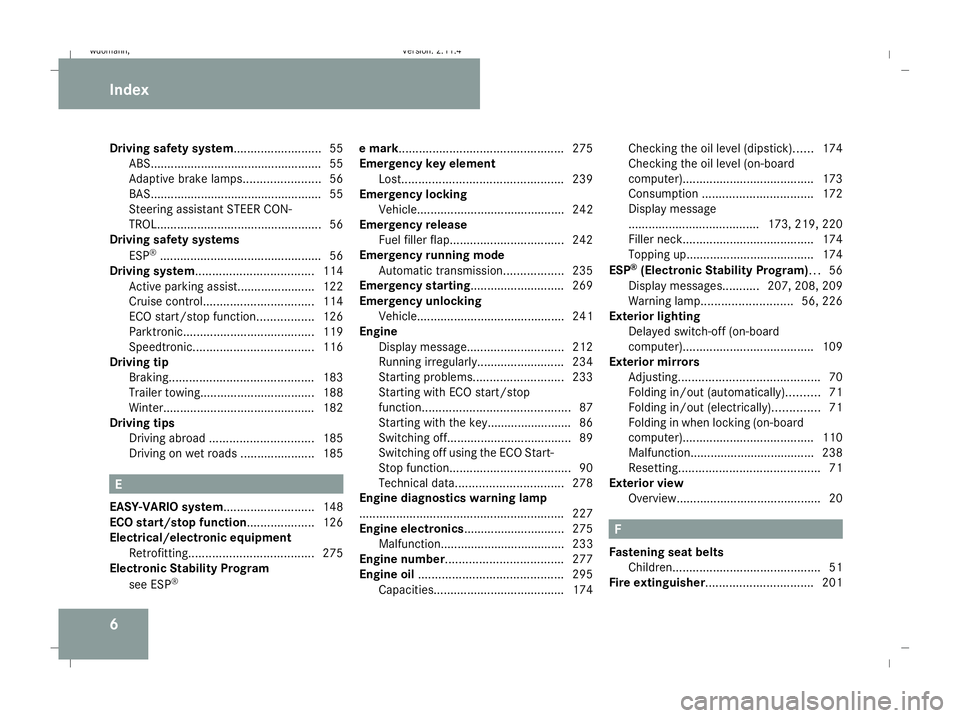
6
Driving safety system
..........................55
ABS. .................................................. 55
Adaptive brake lamps. ......................56
BAS. .................................................. 55
Steering assistant STEER CON-
TROL. ................................................ 56
Driving safety systems
ESP ®
................................................ 56
Driving system................................... 114
Active parking assist. ......................122
Cruise control. ................................ 114
ECO start/stop function .................126
Parktronic. ...................................... 119
Speedtronic. ................................... 116
Driving tip
Braking ........................................... 183
Trailer towing. ................................. 188
Winter ............................................. 182
Driving tips
Driving abroad ............................... 185
Driving on wet roads ......................185 E
EASY-VARIO system ...........................148
ECO start/stop function.................... 126
Electrical/electronic equipment Retrofitting ..................................... 275
Electronic Stability Program
see ESP ® e mark.................................................
275
Emergency key element Lost. ............................................... 239
Emergency locking
Vehicle............................................ 242
Emergency release
Fuel filler fla p.................................. 242
Emergency running mode
Automatic transmission ..................235
Emergency starting............................ 269
Emergency unlocking
Vehicle............................................ 241
Engine
Display message ............................. 212
Running irregularl y.......................... 234
Starting problems ........................... 233
Starting with ECO start/stop
function ............................................ 87
Starting with the key......................... 86
Switching off ..................................... 89
Switching off using the ECO Start-
Stop function .................................... 90
Technical data. ............................... 278
Engine diagnostics warning lamp
............................................................. 227
Engine electronics .............................. 275
Malfunction..................................... 233
Engine number................................... 277
Engine oil ........................................... 295
Capacities.. ..................................... 174Checking the oil level (dipstick).
.....174
Checking the oil level (on-board
computer). ...................................... 173
Consumption ................................. 172
Display message
....................................... 173, 219, 220
Filler neck. ...................................... 174
Topping up. ..................................... 174
ESP ®
(Electronic Stability Program)... 56
Display messages ...........207, 208, 209
Warning lamp. .......................... 56, 226
Exterior lighting
Delayed switch-off (on-board
computer). ...................................... 109
Exterior mirrors
Adjusting .......................................... 70
Folding in/out (automatically). .........71
Folding in/out (electrically). .............71
Folding in when locking (on-board
computer). ...................................... 110
Malfunction..................................... 238
Resetting. ......................................... 71
Exterior view
Overview. .......................................... 20 F
Fastening seat belts Childre n............................................ 51
Fire extinguisher................................ 201Index
245_AKB; 2; 7, en-GB
wdomann,
Version: 2.11.4 2008-10-17T11:22:31+02:00 - Seite 6Dateiname: 6515_1640_02_buchblock.pdf; preflight
Page 15 of 305
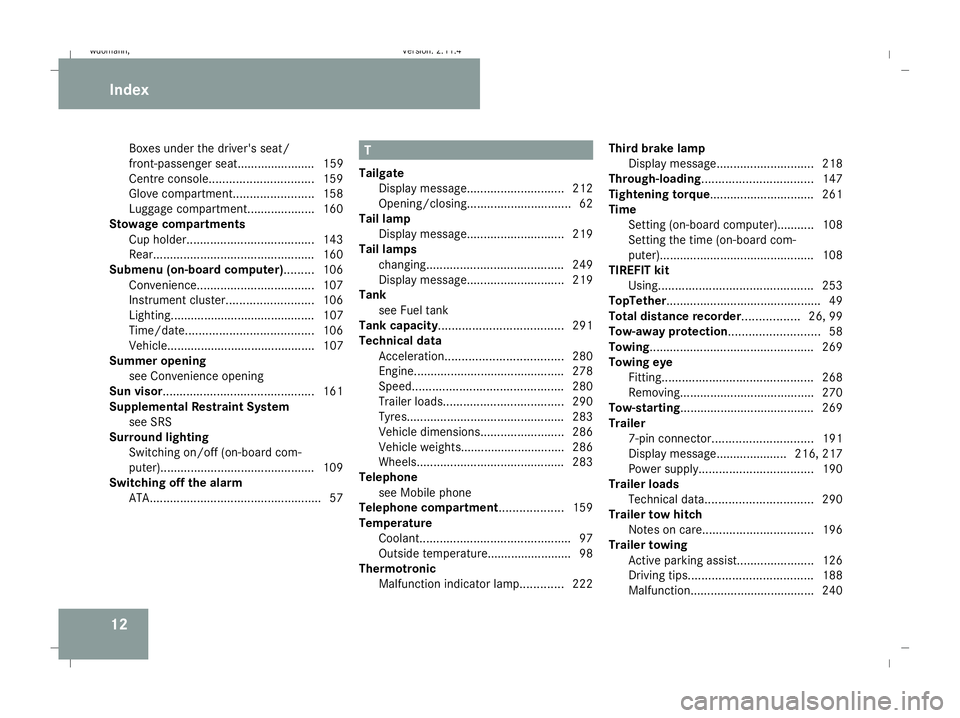
12Boxes under the driver's seat/
front-passenger seat....................... 159
Centre console. .............................. 159
Glove compartment. .......................158
Luggage compartment. ...................160
Stowage compartments
Cup holder ...................................... 143
Rear. ............................................... 160
Submenu (on-board computer)......... 106
Convenience ................................... 107
Instrument cluster .......................... 106
Lighting........................................... 107
Time/date. ..................................... 106
Vehicle............................................ 107
Summer opening
see Convenience opening
Sun visor............................................. 161
Supplemental Restraint System see SRS
Surround lighting
Switching on/off (on-board com-
puter). ............................................. 109
Switching off the alarm
ATA. .................................................. 57 T
Tailgate Display message ............................. 212
Opening/closing. .............................. 62
Tail lamp
Display message ............................. 219
Tail lamps
changing. ........................................ 249
Display message ............................. 219
Tank
see Fuel tank
Tank capacity ..................................... 291
Technical data Acceleration. .................................. 280
Engine............................................ .278
Speed. ............................................ 280
Trailer loads .................................... 290
Tyres. .............................................. 283
Vehicle dimensions. ........................286
Vehicle weights............................... 286
Wheels. ........................................... 283
Telephone
see Mobile phone
Telephone compartment ...................159
Temperature Coolant. ............................................ 97
Outside temperature......................... 98
Thermotronic
Malfunction indicator lamp. ............222Third brake lamp
Display message ............................. 218
Through-loading ................................. 147
Tightening torque............................... 261
Time Setting (on-board computer).......... .108
Setting the time (on-board com-
puter). ............................................. 108
TIREFIT kit
Using. ............................................. 253
TopTether .............................................. 49
Total distance recorder................. 26, 99
Tow-away protection........................... 58
Towing................................................. 269
Towing eye Fitting ............................................. 268
Removing....................................... .270
Tow-starting ........................................ 269
Trailer 7-pin connector .............................. 191
Display message..................... 216, 217
Power supply. ................................. 190
Trailer loads
Technical data. ............................... 290
Trailer tow hitch
Notes on care ................................. 196
Trailer towing
Active parking assist .......................126
Driving tips ..................................... 188
Malfunction..................................... 240 Index
245_AKB; 2; 7, en-GB
wdomann,
Version: 2.11.4 2008-10-17T11:22:31+02:00 - Seite 12Dateiname: 6515_1640_02_buchblock.pdf; preflight
Page 30 of 305
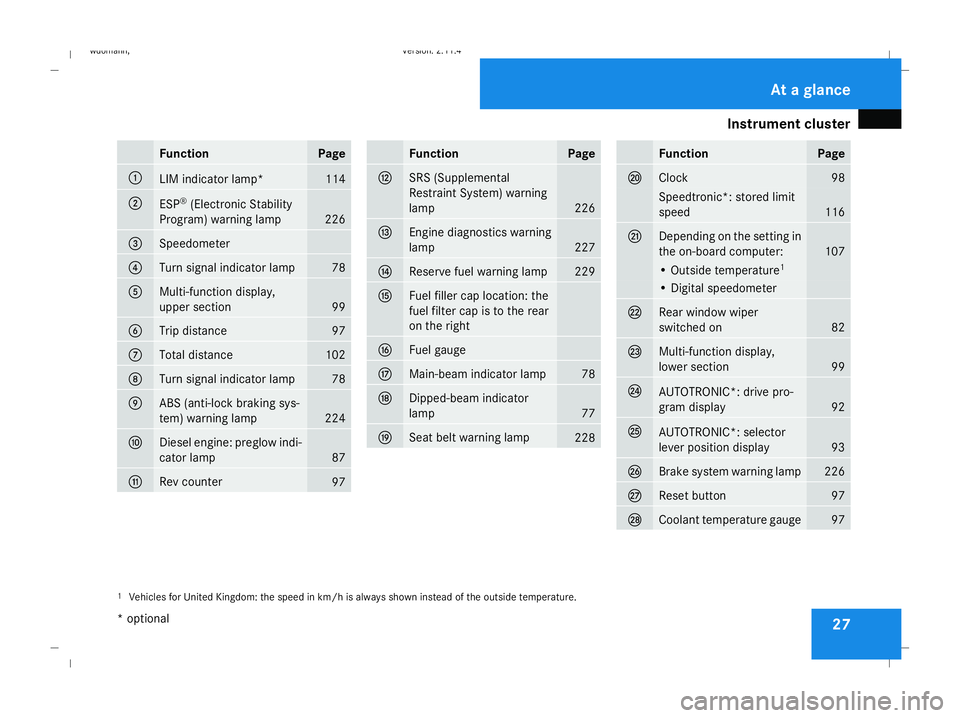
Instrument cluster
27Function Page
1
LIM indicator lamp* 114
2
ESP
®
(Electronic Stability
Program) warning lamp 226
3
Speedometer
4
Turn signal indicator lamp 78
5
Multi-function display,
upper section
99
6
Trip distance 97
7
Total distance 102
8
Turn signal indicator lamp 78
9
ABS (anti-lock braking sys-
tem) warning lamp
224
a
Diesel engine: preglow indi-
cator lamp
87
b
Rev counter
97 Function Page
c
SRS (Supplemental
Restraint System) warning
lamp
226
d
Engine diagnostics warning
lamp
227
e
Reserve fuel warning lamp 229
f
Fuel filler cap location: the
fuel filter cap is to the rear
on the right
g
Fuel gauge
h
Main-beam indicator lamp 78
j
Dipped-beam indicator
lamp
77
k
Seat belt warning lamp
228 Function Page
l
Clock 98
Speedtronic*: stored limit
speed
116
m
Depending on the setting in
the on-board computer:
107
• Outside temperature
1 • Digital speedometer
n
Rear window wiper
switched on
82
o
Multi-function display,
lower section
99
p
AUTOTRONIC*: drive pro-
gram display
92
q
AUTOTRONIC*: selector
lever position display
93
r
Brake system warning lamp 226
s
Reset button 97
t
Coolant temperature gauge 97
1
Vehicles for United Kingdom: the speed in km/h is always shown instead of the outside temperature. At a glance
* optional
245_AKB; 2; 7, en-GB
wdomann
,V ersion: 2.11.4
2008-10-17T11:22:31+02:00 - Seite 27 Dateiname: 6515_1640_02_buchblock.pdf; preflight
Page 32 of 305
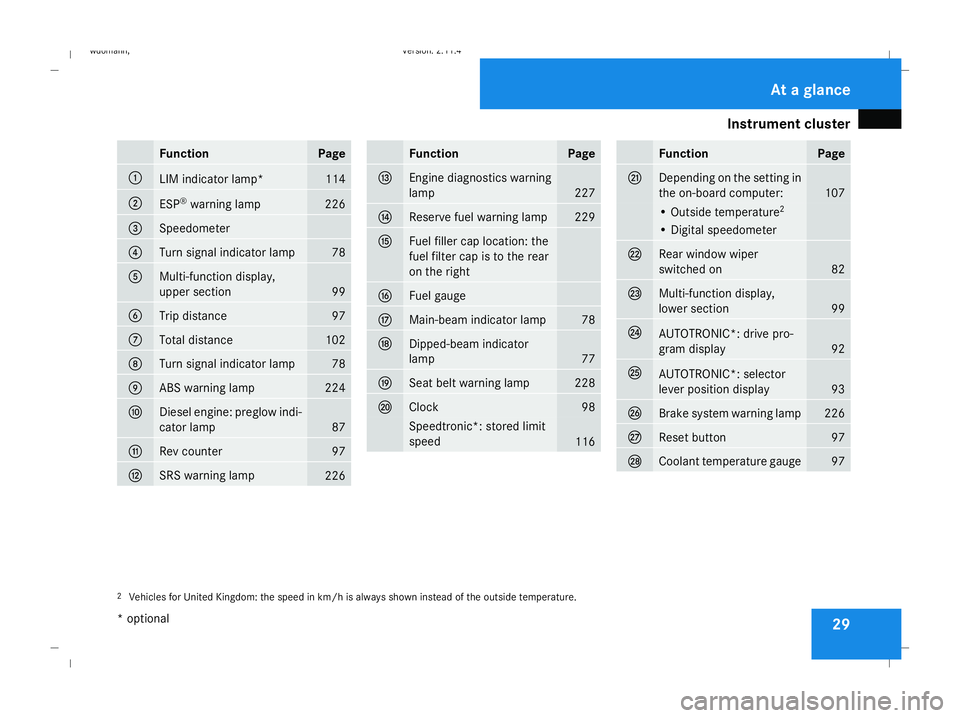
Instrument cluster
29Function Page
1
LIM indicator lamp* 114
2
ESP
®
warning lamp 226
3
Speedometer
4
Turn signal indicator lamp 78
5
Multi-function display,
upper section
99
6
Trip distance 97
7
Total distance 102
8
Turn signal indicator lamp 78
9
ABS warning lamp 224
a
Diesel engine: preglow indi-
cator lamp
87
b
Rev counter 97
c
SRS warning lamp
226 Function Page
d
Engine diagnostics warning
lamp
227
e
Reserve fuel warning lamp 229
f
Fuel filler cap location: the
fuel filter cap is to the rear
on the right
g
Fuel gauge
h
Main-beam indicator lamp 78
j
Dipped-beam indicator
lamp
77
k
Seat belt warning lamp 228
l
Clock 98
Speedtronic*: stored limit
speed
116 Function Page
m
Depending on the setting in
the on-board computer:
107
• Outside temperature
2 • Digital speedometer
n
Rear window wiper
switched on
82
o
Multi-function display,
lower section
99
p
AUTOTRONIC*: drive pro-
gram display
92
q
AUTOTRONIC*: selector
lever position display
93
r
Brake system warning lamp 226
s
Reset button 97
t
Coolant temperature gauge 97
2
Vehicles for United Kingdom: the speed in km/h is always shown instead of the outside temperature. At a glance
* optional
245_AKB; 2; 7, en-GB
wdomann
,V ersion: 2.11.4
2008-10-17T11:22:31+02:00 - Seite 29 Dateiname: 6515_1640_02_buchblock.pdf; preflight
Page 171 of 305
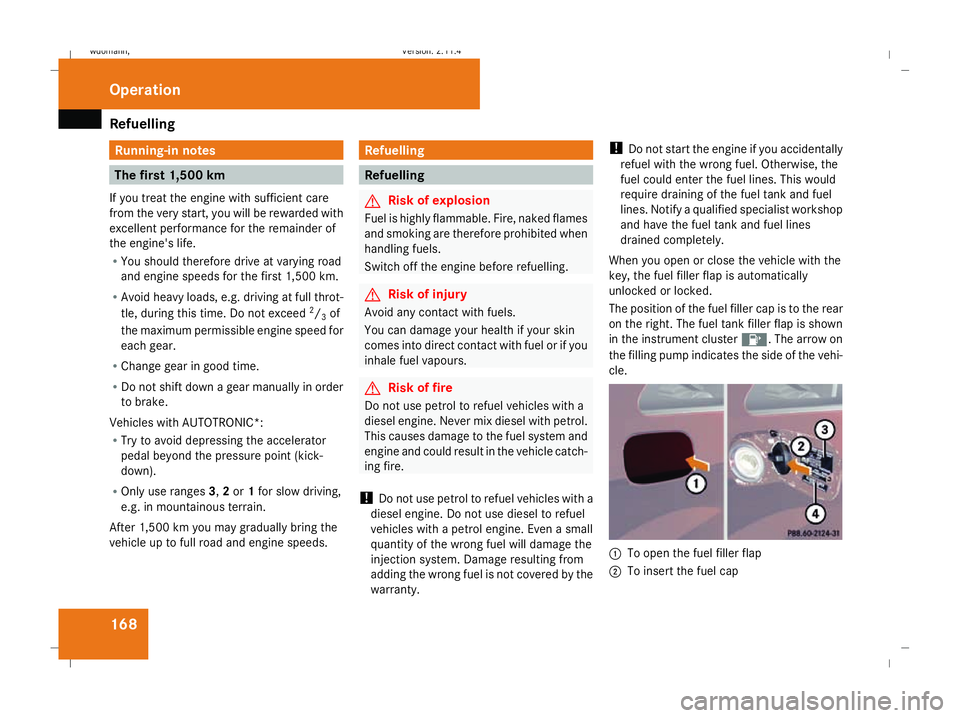
Refuelling
168 Running-in notes
The first 1,500 km
If you treat the engine with sufficient care
from the very start, you will be rewarded with
excellent performance for the remainder of
the engine's life.
R You should therefore drive at varying road
and engine speeds for the first 1,500 km.
R Avoid heavy loads, e.g. driving at full throt-
tle, during this time. Do not exceed 2
/ 3 of
the maximum permissible engine speed for
each gear.
R Change gear in good time.
R Do not shift down a gear manually in order
to brake.
Vehicles with AUTOTRONIC*:
R Try to avoid depressing the accelerator
pedal beyond the pressure point (kick-
down).
R Only use ranges 3,2or 1for slow driving,
e.g. in mountainous terrain.
After 1,500 km you may gradually bring the
vehicle up to full road and engine speeds. Refuelling
Refuelling
G
Risk of explosion
Fuel is highly flammable. Fire, naked flames
and smoking are therefore prohibited when
handling fuels.
Switch off the engine before refuelling. G
Risk of injury
Avoid any contact with fuels.
You can damage your health if your skin
comes into direct contact with fuel or if you
inhale fuel vapours. G
Risk of fire
Do not use petrol to refuel vehicles with a
diesel engine. Never mix diesel with petrol.
This causes damage to the fuel system and
engine and could result in the vehicle catch-
ing fire.
! Do not use petrol to refuel vehicles with a
diesel engine. Do not use diesel to refuel
vehicles with a petrol engine. Even a small
quantity of the wrong fuel will damage the
injection system. Damage resulting from
adding the wrong fuel is not covered by the
warranty. !
Do not start the engine if you accidentally
refuel with the wrong fuel. Otherwise, the
fuel could enter the fuel lines. This would
require draining of the fuel tank and fuel
lines. Notify a qualified specialist workshop
and have the fuel tank and fuel lines
drained completely.
When you open or close the vehicle with the
key, the fuel filler flap is automatically
unlocked or locked.
The position of the fuel filler cap is to the rear
on the right. The fuel tank filler flap is shown
in the instrument cluster 4. The arrow on
the filling pump indicates the side of the vehi-
cle. 1
To open the fuel filler flap
2 To insert the fuel cap Operation
245_AKB; 2; 7, en-GB
wdomann,
Version: 2.11.4 2008-10-17T11:22:31+02:00 - Seite 168Dateiname: 6515_1640_02_buchblock.pdf; preflight
Page 172 of 305
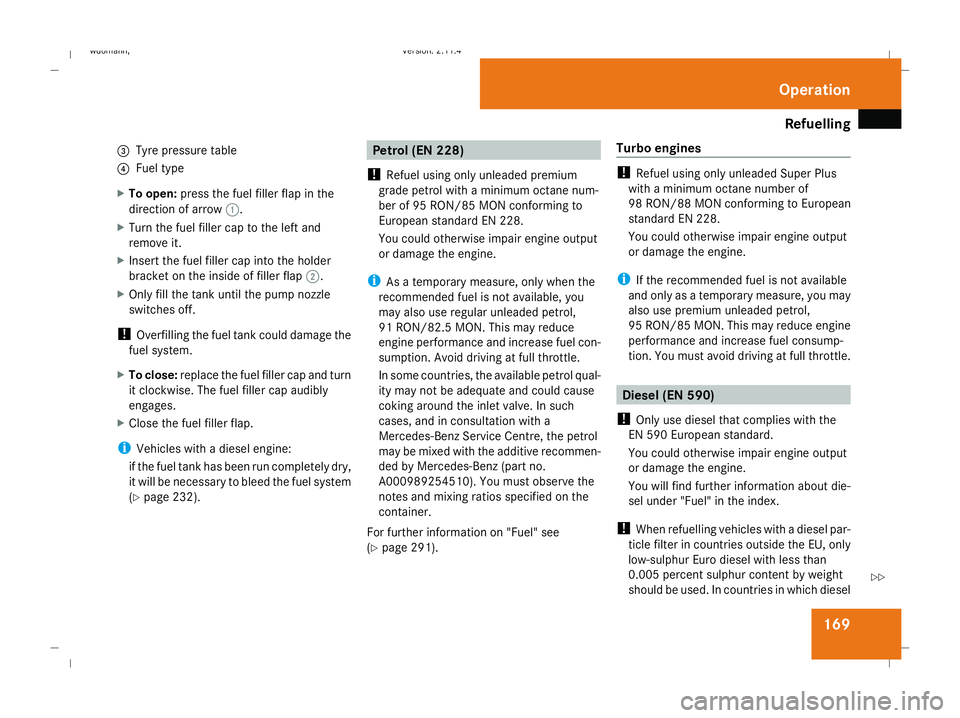
Refuelling
169
3
Tyre pressure table
4 Fuel type
X To open: press the fuel filler flap in the
direction of arrow 1.
X Turn the fuel filler cap to the left and
remove it.
X Insert the fuel filler cap into the holder
bracket on the inside of filler flap 2.
X Only fill the tank until the pump nozzle
switches off.
! Overfilling the fuel tank could damage the
fuel system.
X To close: replace the fuel filler cap and turn
it clockwise. The fuel filler cap audibly
engages.
X Close the fuel filler flap.
i Vehicles with a diesel engine:
if the fuel tank has been run completely dry,
it will be necessary to bleed the fuel system
(Y page 232). Petrol (EN 228)
! Refuel using only unleaded premium
grade petrol with a minimum octane num-
ber of 95 RON/85 MON conforming to
European standard EN 228.
You could otherwise impair engine output
or damage the engine.
i As a temporary measure, only when the
recommended fuel is not available, you
may also use regular unleaded petrol,
91 RON/82.5 MON. This may reduce
engine performance and increase fuel con-
sumption. Avoid driving at full throttle.
In some countries, the available petrol qual-
ity may not be adequate and could cause
coking around the inlet valve. In such
cases, and in consultation with a
Mercedes-Benz Service Centre, the petrol
may be mixed with the additive recommen-
ded by Mercedes-Benz (part no.
A000989254510). You must observe the
notes and mixing ratios specified on the
container.
For further information on "Fuel" see
(Y page 291). Turbo engines !
Refuel using only unleaded Super Plus
with a minimum octane number of
98 RON/88 MON conforming to European
standard EN 228.
You could otherwise impair engine output
or damage the engine.
i If the recommended fuel is not available
and only as a temporary measure, you may
also use premium unleaded petrol,
95 RON/85 MON. This may reduce engine
performance and increase fuel consump-
tion. You must avoid driving at full throttle. Diesel (EN 590)
! Only use diesel that complies with the
EN 590 European standard.
You could otherwise impair engine output
or damage the engine.
You will find further information about die-
sel under "Fuel" in the index.
! When refuelling vehicles with a diesel par-
ticle filter in countries outside the EU, only
low-sulphur Euro diesel with less than
0.005 percent sulphur content by weight
should be used. In countries in which diesel Operation
245_AKB; 2; 7, en-GB
wdomann,
Version: 2.11.4
2008-10-17T11:22:31+02:00 - Seite 169 ZDateiname: 6515_1640_02_buchblock.pdf; preflight
Page 179 of 305
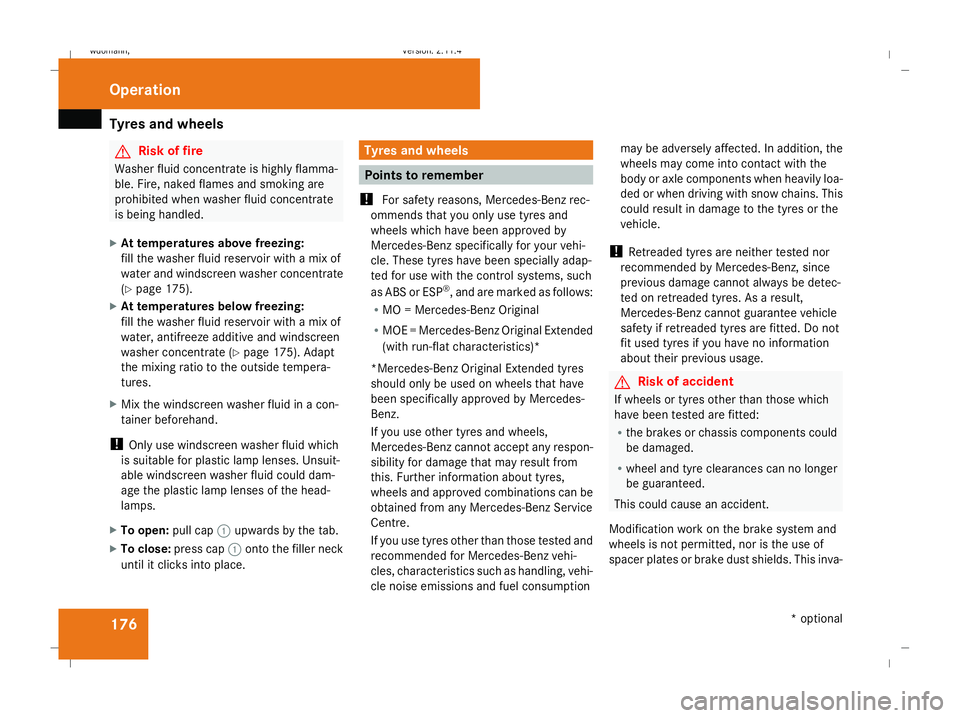
Tyres and wheels
176 G
Risk of fire
Washer fluid concentrate is highly flamma-
ble. Fire, naked flames and smoking are
prohibited when washer fluid concentrate
is being handled.
X At temperatures above freezing:
fill the washer fluid reservoir with a mix of
water and windscreen washer concentrate
(Y page 175).
X At temperatures below freezing:
fill the washer fluid reservoir with a mix of
water, antifreeze additive and windscreen
washer concentrate ( Ypage 175). Adapt
the mixing ratio to the outside tempera-
tures.
X Mix the windscreen washer fluid in a con-
tainer beforehand.
! Only use windscreen washer fluid which
is suitable for plastic lamp lenses. Unsuit-
able windscreen washer fluid could dam-
age the plastic lamp lenses of the head-
lamps.
X To open: pull cap1upwards by the tab.
X To close: press cap 1onto the filler neck
until it clicks into place. Tyres and wheels
Points to remember
! For safety reasons, Mercedes-Benz rec-
ommends that you only use tyres and
wheels which have been approved by
Mercedes-Benz specifically for your vehi-
cle. These tyres have been specially adap-
ted for use with the control systems, such
as ABS or ESP ®
, and are marked as follows:
R MO = Mercedes-Benz Original
R MOE = Mercedes-Benz Original Extended
(with run-flat characteristics)*
*Mercedes-Benz Original Extended tyres
should only be used on wheels that have
been specifically approved by Mercedes-
Benz.
If you use other tyres and wheels,
Mercedes-Benz cannot accept any respon-
sibility for damage that may result from
this. Further information about tyres,
wheels and approved combinations can be
obtained from any Mercedes-Benz Service
Centre.
If you use tyres other than those tested and
recommended for Mercedes-Benz vehi-
cles, characteristics such as handling, vehi-
cle noise emissions and fuel consumption may be adversely affected. In addition, the
wheels may come into contact with the
body or axle components when heavily loa-
ded or when driving with snow chains. This
could result in damage to the tyres or the
vehicle.
! Retreaded tyres are neither tested nor
recommended by Mercedes-Benz, since
previous damage cannot always be detec-
ted on retreaded tyres. As a result,
Mercedes-Benz cannot guarantee vehicle
safety if retreaded tyres are fitted. Do not
fit used tyres if you have no information
about their previous usage. G
Risk of accident
If wheels or tyres other than those which
have been tested are fitted:
R the brakes or chassis components could
be damaged.
R wheel and tyre clearances can no longer
be guaranteed.
This could cause an accident.
Modification work on the brake system and
wheels is not permitted, nor is the use of
spacer plates or brake dust shields. This inva- Operation
* optional
245_AKB; 2; 7, en-GB
wdomann,
Version: 2.11.4 2008-10-17T11:22:31+02:00 - Seite 176Dateiname: 6515_1640_02_buchblock.pdf; preflight
Page 192 of 305
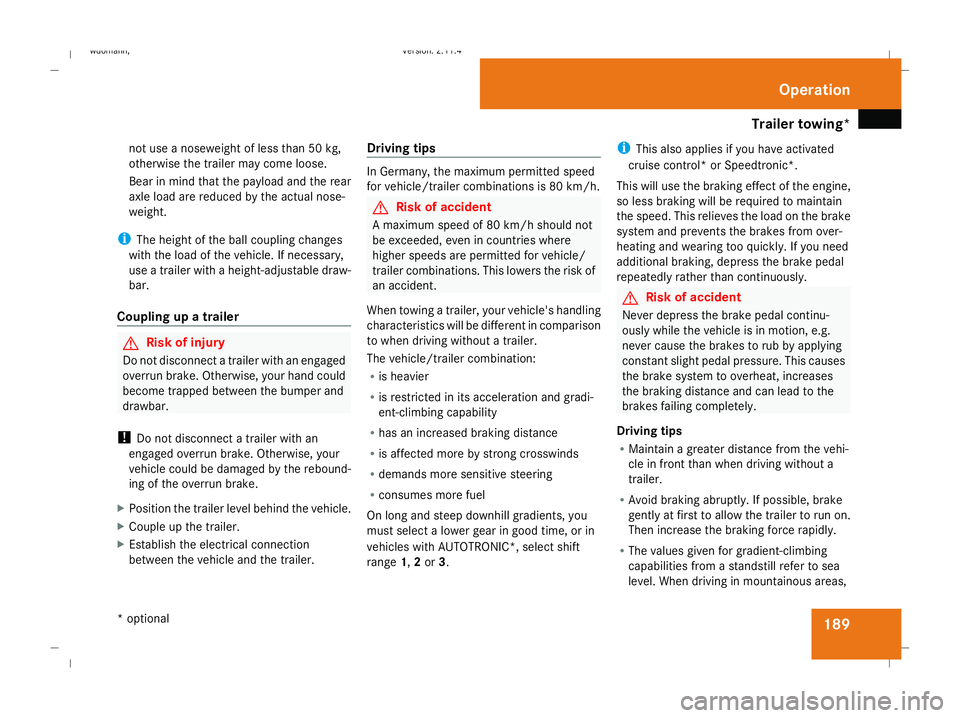
Trailer towing*
189
not use a noseweight of less than 50 kg,
otherwise the trailer may come loose.
Bear in mind that the payload and the rear
axle load are reduced by the actual nose-
weight.
i The height of the ball coupling changes
with the load of the vehicle. If necessary,
use a trailer with a height-adjustable draw-
bar.
Coupling up a trailer G
Risk of injury
Do not disconnect a trailer with an engaged
overrun brake. Otherwise, your hand could
become trapped between the bumper and
drawbar.
! Do not disconnect a trailer with an
engaged overrun brake. Otherwise, your
vehicle could be damaged by the rebound-
ing of the overrun brake.
X Position the trailer level behind the vehicle.
X Couple up the trailer.
X Establish the electrical connection
between the vehicle and the trailer. Driving tips In Germany, the maximum permitted speed
for vehicle/trailer combinations is 80 km/h.
G
Risk of accident
A maximum speed of 80 km/h should not
be exceeded, even in countries where
higher speeds are permitted for vehicle/
trailer combinations. This lowers the risk of
an accident.
When towing a trailer, your vehicle's handling
characteristics will be different in comparison
to when driving without a trailer.
The vehicle/trailer combination:
R is heavier
R is restricted in its acceleration and gradi-
ent-climbing capability
R has an increased braking distance
R is affected more by strong crosswinds
R demands more sensitive steering
R consumes more fuel
On long and steep downhill gradients, you
must select a lower gear in good time, or in
vehicles with AUTOTRONIC*, select shift
range 1,2or 3. i
This also applies if you have activated
cruise control* or Speedtronic*.
This will use the braking effect of the engine,
so less braking will be required to maintain
the speed. This relieves the load on the brake
system and prevents the brakes from over-
heating and wearing too quickly. If you need
additional braking, depress the brake pedal
repeatedly rather than continuously. G
Risk of accident
Never depress the brake pedal continu-
ously while the vehicle is in motion, e.g.
never cause the brakes to rub by applying
constant slight pedal pressure. This causes
the brake system to overheat, increases
the braking distance and can lead to the
brakes failing completely.
Driving tips
R Maintain a greater distance from the vehi-
cle in front than when driving without a
trailer.
R Avoid braking abruptly. If possible, brake
gently at first to allow the trailer to run on.
Then increase the braking force rapidly.
R The values given for gradient-climbing
capabilities from a standstill refer to sea
level. When driving in mountainous areas, Operation
* optional
245_AKB; 2; 7, en-GB
wdomann,
Version: 2.11.4
2008-10-17T11:22:31+02:00 - Seite 189 ZDateiname: 6515_1640_02_buchblock.pdf; preflight
Page 294 of 305

Service products and capacities
291Service products and capacities
Notes on service products and capaci-
ties
Service products are:
R fuels (e.g. petrol, diesel)
R lubricants (e.g. engine oil, transmission oil)
R coolant
R brake fluid
R windscreen washer fluid
Mercedes-Benz recommends that you only
use those products which have been tested
and specially approved by Mercedes-Benz for
your vehicle and are listed in the Mercedes-
Benz Owner's Manual in the relevant chapter
since:
R parts and service products are matched
R damage caused by the use of non-approved
service products is not covered by the war-
ranty
You can recognise service products approved
by Mercedes-Benz by the following inscrip-
tion on the containers:
R MB-Freigabe (e.g. MB-Freigabe 229.51)
R MB Approval (e.g. MB Approval 229.51) Other designations or recommendations that
relate to a level of quality or a specification in
accordance with an MB Approval have not
necessarily been approved by Mercedes-
Benz.
You can obtain further information from any
Mercedes-Benz Service Centre. G
Risk of injury
When handling, storing and disposing of
any service products, please observe the
relevant regulations, as, otherwise, you
could endanger yourself and others.
Keep service products away from children.
To protect your health, do not allow service
products to come into contact with your
eyes or open wounds. See a doctor imme-
diately if any service product is swallowed. H
Environmental note
Dispose of service products in an environ-
mentally-responsible manner. Fuels
G
Risk of explosion
Fuel is highly flammable. Fire, naked flames
and smoking are therefore prohibited when
handling fuels.
Switch off the engine before refuelling. G
Risk of injury
Do not allow fuel to come into contact with
skin or clothing.
Allowing fuels to come into direct contact
with your skin or inhaling fuel vapours is
damaging to your health.
Tank capacity Total capacity 54 l
Of which reserve
fuel
Approximately 6 l
!
Do not use petrol to refuel vehicles with a
diesel engine. Do not use diesel to refuel
vehicles with a petrol engine. Never mix
diesel with petrol. Even small amounts of
the wrong fuel result in damage to the
injection system. Damage resulting from Technical data
245_AKB; 2; 7, en-GB
wdomann,
Version: 2.11.4
2008-10-17T11:22:31+02:00 - Seite 291 ZDateiname: 6515_1640_02_buchblock.pdf; preflight
Page 295 of 305

Service products and capacities
292adding the wrong fuel is not covered by the
warranty.
More information about refuelling and fuels
can be found on (Y page 168). Introduction to fuel consumption
The vehicle will use more fuel than usual in
the following situations:
R at very low temperatures
R in urban traffic
R on short trips
R when towing a trailer
R in mountainous terrain The consumption figures have been deter-
mined according to EU Directive
RL 80
/1268 /EEC.
i Only for certain countries: the respective
current consumption and emission values
of your vehicle can be found in the COC
papers (EC-CERTIFICATE OF CONFORM-
ITY). These documents are supplied when
the vehicle is delivered.
! Do not use any special additives, as they
can cause malfunctions and engine dam-
age. Damage resulting from the use of such
additives is not covered by the Mercedes-
Benz warranty. H
Environmental note
CO 2(carbon dioxide) is the gas which sci-
entists believe to be principally responsible
for global warming (the greenhouse effect).
Your vehicle's CO 2emissions are directly
related to fuel consumption and therefore
depend on:
R efficient use of the fuel by the engine
R driving style
R other non-technical factors, such as envi-
ronmental influences or road conditions
You can minimise your vehicle's CO 2emis-
sions by driving carefully and having it serv-
iced regularly. Technical data
245_AKB; 2; 7, en-GB
wdomann,
Version: 2.11.4 2008-10-17T11:22:31+02:00 - Seite 292Dateiname: 6515_1640_02_buchblock.pdf; preflight